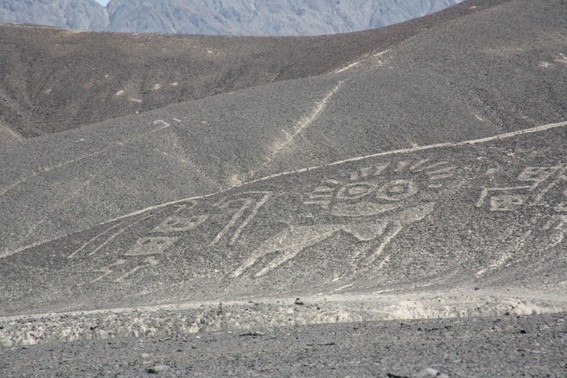
Along with mysterious lines present in the arid area of Nazca in Peru we can also observe comparable lines drawn many years ago in California near the town of Blythe. The Fort Yuma Indian Reservation on the lower Colorado River is near this town and the drawings therefore bear the name Blythe Intaglios.
On another part of the world you may see similar mysterious drawings in a neighborhood of Nazca, a small town at the mouth of the river that goes into the Pacific Ocean. The city is some 400 km south of Lima in Peru. It lies near the system of valleys and plateaus on the southern coast of Peru, where these famous drawings can be seen. Nazca is also the name used for the Nazca culture that flourished in the area some time around and after the year 300 BC.
The lines - both in Nazca and Blythe - only give complete images if we see them from above (from an airplane). Unlike in Peru, where we can no longer meet indigenous people directly associated with the drawings, the original inhabitants (Indians) still live on the lower Colorado River near Blythe. Quetsan or Quechan, sometimes Yuma, Yuman, Kwtsan, Kwtsaan, is the name for the Indians that live here. The word Yuma comes from an old name used for a group of Native American ethnic groups.
The Yuma people, who today prefer to be called rather the Quechan, have long been known as very good fighters.
Apart from the very well known Dänikin-type hypotheses that imagine aliens everywhere in ancient archeology if it is possible, we can explain the purpose of the Nazca and Blythe lines simply:
1 The patterns correspond to constellations of the stars.
2 The purpose of their creation was of a ceremonial (ritual) character.
3 The lines secretly point to some underground places.
Ancient aqueducts are really present in the Nazca region and together with these very old sky drawings they are, too, some 2000 years old.
Even today, these ancient aqueducts (underground water tunnels) are used for irrigation in the Nazca region and they belong to the group of a few unparalleled construction works of the South American Indians.
The underground water tunnels are accessible even today. It is therefore quite probable that these lines may contain encrypted information on how to find some underground spaces. We can go perhaps even further and think of these theoretical underground locations as something that has a connection to ancient secrets, or even pathways to the Aghartha.
Lore Cachora, the Quetsan elder, says that the drawings were used for rituals and as these patterns produce a complete picture only from above, religious ceremonies took place on them. The Indians used them for the same purpose as we use our churches today. Lore Cachora further says that figures of the drawings represent deities of the Creation. One such a deity is Mastamho - the grandson of Mother Earth (Pachamama) and the Heavenly Father.
David Whitley, one of the leading experts on ancient drawings, confirms this, too. In his opinion, the ceremonial significance of the Blythe intaglios could have the same spirit as the ancient creators of the Nazca lines possessed, but unfortunately, we cannot say this for sure. The Blythe intaglios definitely picture the Creation, but as far as the Nazca lines in Peru are concerned, we do not have enough arguments to say the same thing.

























